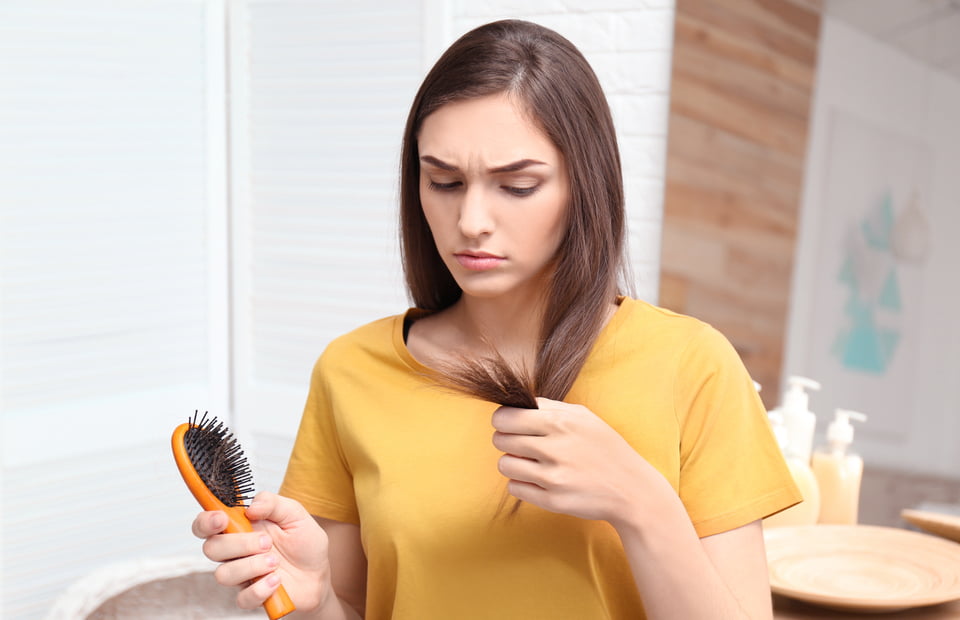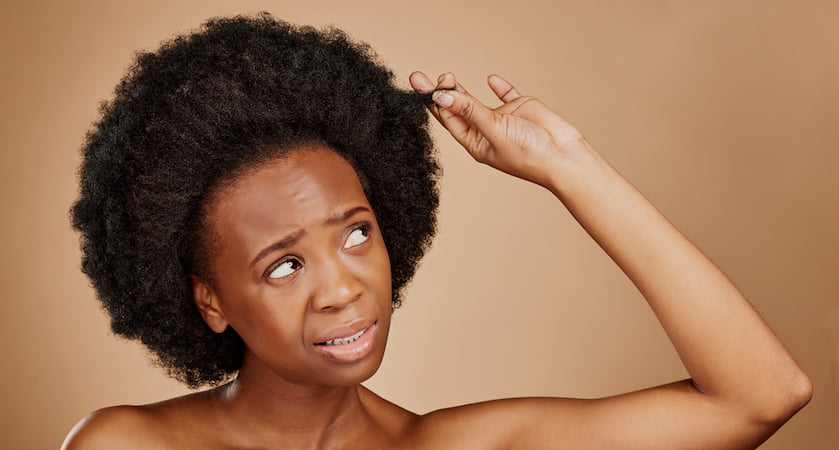
Types of Hair Loss: Symptoms, Causes, Treatment, and Remedies Explained
Did you know that there can be many different types of hair loss?
While hair loss is a common concern that affects millions of people worldwide, it's important to understand the different types because that's the first step toward finding the right solution for your hair concerns.
Short Summary
-
Understand the types, symptoms and causes of common hair loss
-
Consider medications, natural remedies or surgery to address hair loss
-
Take preventive measures such as gentle hair care practices & stress management for healthy hair
Understanding Hair Loss: Common Types and Causes
Hair loss is a complex issue with a variety of causes, ranging from genetics and hormonal changes to medical conditions and lifestyle choices.
It can manifest in different ways, such as sudden hair loss, patchy hair loss, or overall hair thinning, and can be temporary or permanent.
In this section, we will explore the four common types of hair loss: androgenetic alopecia, alopecia areata, traction alopecia, and scarring alopecia.
By understanding these conditions, you can make informed decisions about the best course of action for your hair and scalp health.
Being familiar with the factors that contribute to hair loss can help you make lifestyle adjustments or seek necessary treatments to minimize hair shedding and promote new hair growth.
In the following sections, we will delve into the specifics of each type of hair loss, their symptoms, causes, and treatment options.
Androgenetic Alopecia
Androgenetic alopecia, or male and female pattern hair loss, is the most common type of hair loss, affecting millions of people worldwide.
This condition is believed to be caused by a combination of genetic and hormonal influences.
Male pattern baldness typically begins with a receding hairline and progresses to thinning at the crown, creating an “M” shape.
Female pattern baldness, on the other hand, involves a gradual thinning of hair all over the scalp, often appearing as widening or thinning around the part.
In both cases, hair falls at an increased rate, leading to visible signs of hair loss.
Early treatment can help slow hair loss in androgenetic alopecia, so it’s essential to recognize the symptoms and seek professional advice as soon as possible.
With proper intervention, many individuals can successfully manage their hair loss and maintain a healthy, full head of hair.
Alopecia Areata
Alopecia areata is an autoimmune condition that results in patchy hair loss.
This type of hair loss occurs when the immune system mistakenly attacks hair follicles, leading to hair loss not only on the scalp but also on other areas of the body, such as eyebrows and eyelashes.
There are two subtypes of alopecia areata. Alopecia totalis leads to complete loss of hair on the scalp. Alopecia universalis is a severe form of hair loss that results in complete loss of hair on the scalp and body.
The good news is that hair loss due to alopecia areata can often be treated, allowing the hair to regrow.
Treatment options for alopecia areata include injections into the scalp every 4-6 weeks for up to 6 months, and prescription medications to promote hair regrowth.
By working closely with a healthcare professional, individuals with alopecia areata can find the most effective treatment plan to manage their hair loss and restore their confidence.
Traction Alopecia
Traction alopecia is a type of hair loss caused by constant pulling force on the hair follicles, often due to tight hairstyles such as braids, dreadlocks, or tight ponytails.
This condition is especially prevalent in women of African descent with tight, spiral curling hair. The excessive tension on the hair follicles leads to hair breakage and bald spots.
The most effective treatment for traction alopecia is to modify the hairstyle and abstain from tight hairstyles, allowing the hair to regrow naturally.
In certain cases, medications such as minoxidil and finasteride may be prescribed to facilitate hair regrowth.
By implementing gentle hair care practices and avoiding tight hairstyles, individuals can prevent traction alopecia and maintain healthy hair growth.
Scarring Alopecia
Scarring alopecia is characterized by inflammation and scar tissue formation in hair follicles, leading to permanent hair loss.
This type of hair loss may begin gradually or suddenly, with symptoms such as severe itching, swelling, and red or white lesions on the scalp resembling a rash.
Various types of scarring alopecia exist, including frontal fibrosing alopecia, cicatricial alopecia, folliculitis decalvans, dissecting cellulitis of the scalp, and others.
Treatment for scarring alopecia depends on the specific type and cause of the condition.
A healthcare professional can help determine the most appropriate course of action, which may include medications, lifestyle changes, or surgery.
By addressing the underlying cause of scarring alopecia, individuals can manage their hair loss and regain confidence in their appearance.
Factors Contributing to Hair Thinning and Loss
Various factors contribute to hair thinning and loss, such as nutritional deficiencies, stress, and medical conditions or treatments.
Understanding these factors can help you make informed decisions about your hair care routine and seek appropriate treatments if necessary.
In this section, we will discuss the role of nutrition, stress, and medical conditions in hair thinning and loss, and provide practical tips for addressing these issues.
Being aware of the factors that contribute to hair loss can empower you to take control of your hair health and make necessary lifestyle adjustments.
In the following subsections, we will delve into the specifics of each factor and offer tips for minimizing hair loss and promoting healthy hair growth.
Nutritional Deficiencies
Nutritional deficiencies occur when the body lacks essential vitamins, minerals, and other nutrients required for optimal functioning.
These deficiencies can lead to hair loss, as the body is unable to sustain healthy hair growth without the necessary nutrients.
Ensuring that your diet includes a wide variety of nutrient-rich foods can help support hair health and potentially prevent hair loss.
A well-balanced diet supplemented with prescribed supplements, if needed, can help promote healthy hair growth.
By consuming a diet rich in proteins, fats, and key vitamins and minerals, you can provide your body with the necessary nutrients to maintain strong, healthy hair and minimize hair shedding.
Stress-Related Hair Loss
Stress-related hair loss, such as telogen effluvium, can be acute or chronic and may resolve on its own or require treatment.
It is important to recognize that stress can contribute to hair loss, so implementing stress management techniques may help reduce the risk of stress-related hair loss.
Various stress management techniques and self-care practices can help reduce stress levels and minimize the impact of stress on hair health.
Examples include relaxation practices like deep breathing, meditation, or yoga; engaging in regular exercise; maintaining a nutritious and balanced diet; ensuring ample sleep; and actively managing stress levels.
By incorporating these practices into your daily routine, you can support your overall well-being and potentially prevent stress-related hair loss.
Medical Conditions and Treatments
Medical conditions and treatments, such as chemotherapy or hormonal imbalances, can cause hair loss, which may be temporary or permanent.
Hair loss due to medical conditions or treatments can be attributed to disruptions in the normal hair growth cycle, inflammation of the hair follicles, and/or hormonal imbalances.
Treatments for medical conditions that cause hair thinning and loss include medications such as minoxidil, finasteride, and corticosteroids; lifestyle changes such as stress management, gentle hair care practices, and a healthy diet; and surgery, including hair transplantation.
By working closely with a healthcare professional, individuals experiencing losing hair due to medical conditions or treatments can find the most effective treatment plan to manage their hair loss and restore their confidence.
Regrowth and Treatment Options
If you are experiencing hair loss, it is important to know that there are various regrowth and treatment options available.
The most suitable option for you will depend on the underlying cause of your hair loss and your individual needs and preferences.
In this section, we will discuss the different regrowth and treatment options, including medications, natural remedies, and hair transplant surgery.
Each treatment option has its own advantages and potential drawbacks.
By understanding the different options available, you can make an informed decision about which treatment is best suited to your specific hair loss situation and personal preferences.
Medications: Minoxidil and Finasteride
Minoxidil and finasteride are medications used to treat hair loss, with varying degrees of success and potential side effects.
Minoxidil is a topical medication that is applied directly to the scalp and is used to address male-pattern baldness.
Finasteride is an oral medication that is utilized to treat male-pattern baldness. Both medications have been approved by the FDA for the treatment of androgenetic alopecia.
While these medications can be effective for some individuals, they may not work for everyone and can have potential side effects.
It is important to discuss the risks and benefits of these medications with a healthcare professional before beginning treatment to ensure that they are appropriate for your specific hair loss situation.
Natural Remedies and Supplements
Natural remedies and supplements, such as essential oils and hair-healthy foods, can promote hair growth, but research is limited.
Some studies have suggested that essential oils like peppermint, rosemary, and lavender may stimulate hair growth by increasing blood flow to the scalp.
However, it is important to note that not all natural remedies and supplements have scientific backing, and the FDA does not oversee or regulate the quality or purity of essential oils.
It is recommended to consult a healthcare professional before using any natural remedies or supplements for hair loss and to ensure the quality of the products you use.
Hair Transplant Surgery
Hair transplant surgery is an effective option for some types of hair loss, particularly inherited baldness.
The procedure involves the relocation of small grafts containing a few hairs to bald areas of the scalp.
This can be a successful treatment for individuals with inherited baldness, as they generally experience hair loss on the scalp’s crown.
While hair transplant surgery can be an effective solution for many individuals, it is important to consider the risks and potential complications associated with the procedure.
It is also essential to consult with a qualified hair transplant surgeon to determine if this treatment option is appropriate for your specific hair loss situation.
Tips for Preventing Hair Loss
Maintaining healthy hair and preventing hair loss involves a combination of gentle hair care practices, stress management, and maintaining a healthy diet.
In this section, we will discuss these preventive measures in detail, providing practical tips for maintaining strong, healthy hair and minimizing hair shedding.
By incorporating these tips into your daily routine, you can support your hair health and potentially prevent hair loss.
In the following subsections, we will delve into the specifics of each preventive measure and offer practical advice for incorporating them into your lifestyle.
Gentle Hair Care Practices
Gentle hair care practices are essential to maintaining healthy hair and minimizing hair loss. This includes avoiding harsh styling products and tools that can damage hair and cause breakage.
For example, heated tools should be used sparingly, and gentle baby shampoo is recommended for washing your hair.
It is also advised to wash your hair every other day or less, unless you have excessively oily hair.
By implementing these gentle hair care practices, you can help preserve the health and strength of your hair, reduce the risk of breakage, and minimize hair shedding.
Your hair will thank you for treating it with care and kindness.
Stress Management
Managing stress is a crucial aspect of maintaining healthy hair and preventing hair loss.
As we discussed earlier, stress can contribute to hair loss, so implementing stress management techniques may help reduce the risk of stress-related hair loss.
Some effective stress management techniques include relaxation practices like deep breathing, meditation, or yoga; engaging in regular exercise; maintaining a nutritious and balanced diet; ensuring ample sleep; and actively managing stress levels.
By incorporating these practices into your daily routine, you can support your overall well-being and potentially prevent stress-related hair loss.
Diet and Nutrition
A balanced diet rich in vitamins and minerals is essential for promoting hair health and potentially preventing hair loss.
Consuming a diet that includes a variety of fruits and vegetables, lean proteins, healthy fats, and whole grains can help provide your body with the necessary nutrients for maintaining strong, healthy hair.
By incorporating nutrient-rich foods into your daily meals and snacks, you can support your hair health and minimize hair shedding.
Remember that a healthy diet is not only beneficial for your hair, but also for your overall health and well-being.
Summary
In conclusion, understanding the different types of hair loss, their causes, and available treatments is crucial for managing and preventing hair loss.
By implementing gentle hair care practices, stress management techniques, and maintaining a healthy diet, you can support your hair health and potentially prevent hair loss.
Remember that every individual’s hair loss journey is unique, and it is essential to consult with a healthcare professional to determine the best course of action for your specific situation.
Embrace your hair journey with confidence, knowing that you are equipped with the knowledge and tools to maintain strong, healthy hair.
Frequently Asked Questions
How do I know what kind of hair loss I have?
A physical exam conducted by a dermatologist is the best way to determine the pattern and amount of hair loss, as well as check for any inflammation, redness, sores, or scarring.
This exam can help identify the underlying cause of the hair loss, which can range from genetics to medical conditions to lifestyle factors. It can also help determine the best course of treatment for the individual.
What are the three types of hair loss?
There are three main types of hair loss: alopecia areata, alopecia totalis and alopecia universalis.
Alopecia universalis is the most severe form of alopecia areata, causing the complete loss of all body hair.
What type of hair falls out the most?
Androgenetic alopecia is the most common type of hair loss, affecting both men and women. It is caused by hereditary hair loss and is the most common cause of hair loss worldwide.
What is stage 4 hair loss?
Stage 4 hair loss involves significant hairline recession and thinning or loss of hair at the crown. It is one of the later stages in male pattern baldness, with stage 5 being a further progression.
Connecting the recession to a bald spot on the crown marks the final stage of male pattern baldness.
Can nutritional deficiencies cause hair loss?
Yes, nutritional deficiencies can cause hair loss as the body needs essential nutrients to maintain healthy hair growth.
These essential nutrients include proteins, vitamins, minerals, and essential fatty acids. Without these nutrients, the body cannot produce the hormones and proteins necessary for healthy hair growth. Additionally, a lack of information.


